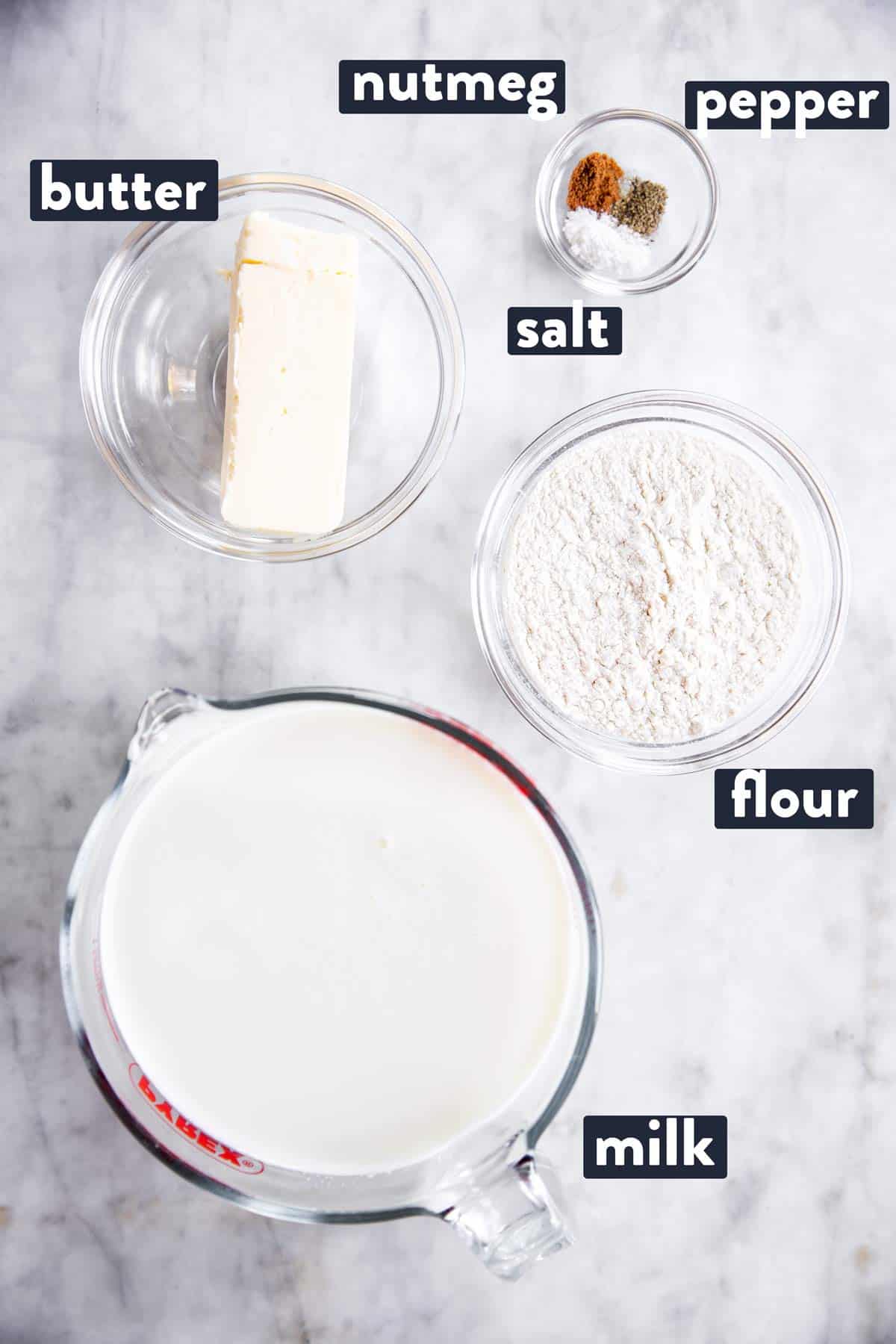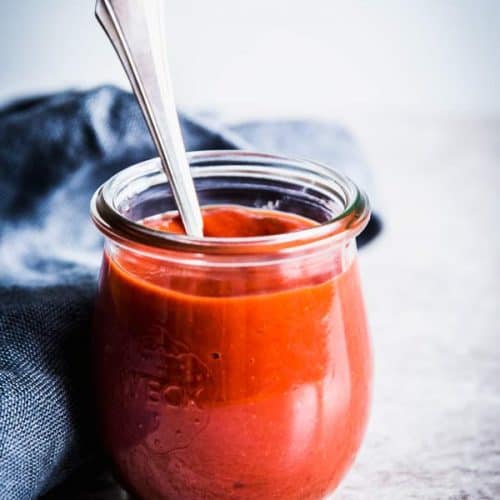A Classic Béchamel Sauce (also known as “white sauce”) is one of the most simple recipes out there, but it is such a great technique to know!
Made with a roux, milk and nutmeg, this turns into a base for so many delicious recipes – from classic Lasagna to creamy pastas and even as a sauce for vegetables or a decadent Mac and Cheese.

Homemade Béchamel Sauce
I think Béchamel is one of the first classic sauces I learned to cook – when I wanted to make Cauliflower Cheese for my youngest brother. Even back then as a teen I was surprised how easy it was (when it seemed like it should be so much more difficult!) and how often I’d use this technique in my cooking later in life.
- A Béchamel sauce is the base for many recipes – a great Mac and Cheese, the white sauce in Lasagna, or even for something simple like creamed spinach!
- It’s a very short recipe with just a few basic ingredients, but the combination is truly magical.
- This recipe is quick – the sauce is finished in less than 10 minutes. Yes, it really is that easy!
Ingredients you’ll need
Here is a visual overview of the ingredients in the recipe. Scroll down to the printable recipe card at the bottom of this post for quantities!

Ingredient notes
- Butter: Butter is a big part of the richness for this sauce, so please do not use oil or spreadable margarine as a substitute. If you need this to be dairy free, I strongly recommend making it with the best vegan butter substitute you can find. At the very least, use a decent stick margarine if you can’t have butter.
- Milk: For the richest sauce, you’ll want to go with whole milk here. Although 2% also works great. Any milk with less fat content will yield a less rich/creamy sauce. The recipe still works, the taste and texture are just a little different.
- Flour: Use all-purpose flour for this recipe. Please do not use whole wheat as a substitute, as it will alter the color of the sauce.
- Nutmeg: Nutmeg is a must in classic Béchamel. It’s only a pinch and works very well with the flavor of the sauce. Don’t worry, it will not make it taste like pumpkin spice latte.
How to make Béchamel Sauce from scratch
1. Melt the butter in a saucepan over medium heat, then whisk in the flour until smooth.
2. Cook the flour/butter mixture on medium-low heat, whisking constantly, for 2-4 minutes. The flour must not brown!
whisk flour into melted butter cook on medium heat whisk in milk simmer until thickened
3. Gradually whisk in the milk (many recipes call for warmed milk, but my husband (a professional chef) was trained to use cold milk; so that’s how we make it at home).
4. Keep whisking your sauce and simmer it over medium heat until it has thickened and coats the back of a spoon. Use in your favorite recipes.

Recipe tips
- Do not brown the flour, it needs to stay fully light in color for a Béchamel sauce.
- This sauce isn’t a “set it and forget it” kind of recipe. You need to constantly babysit and whisk it. It cooks quickly, so it really isn’t that big of a burden, but I wanted to mention it so you don’t walk away from your saucepan while it’s on the stove.
- Only use medium-low heat after adding the milk, Béchamel catches on the bottom of the pot quickly when set over too high a heat.
- I’m adding the classic ratio for Béchamel sauce in the recipe card below, which yields a fairly thick sauce. But you can alter the amount of milk added to suit the recipe you’ll want to use it in. The texture as-is is perfect for my Lasagna (you want to add 1 cup of grated parmesan cheese to the Béchamel for Lasagna, too). But if you need a more liquid-y sauce for your recipe, you can thin it out with more milk.
- The sauce thickens as it cools and gets more liquid again as it heats up (kind of like condensed cream soups). So keep that in mind if you want to change the thickness – only add more milk if the sauce really needs it.
How to make a Roux/Béchamel sauce for beginners
This technique is called making a roux (cooking flour in butter) to make a Béchamel sauce (adding milk/cream to create a creamy, thickened white sauce). Here are my tips to make a roux without messing it up if you are a beginner:
- You must use medium to medium-low heat to cook the flour/butter mixture and the flour mustn’t brown.
- If you are new to making roux, I highly recommend taking the pot off the heat to stir in the flour. This gives you a little more time to avoid lumps and to keep the flour from getting too hot. Once you have fully stirred the flour into the butter, place the pot back over medium heat again and cook for 30-60 seconds, stirring constantly, until the flour is foamy.
- Now take the pot off the heat again and gradually stir in the milk. This is not how you usually make a béchamel sauce (you’d leave it on the heat), but I have tested this several times and for beginners, it’s an absolutely easy way to make a great roux/béchamel without creating a lumpy or burned sauce.
- Once you have fully combined the milk (plus any other liquid your recipe calls for) with the flour mixture, set the pot back over medium-low heat and simmer until thickened while constantly stirring.

Béchamel FAQs
You can make your Béchamel sauce up to a day ahead of time. Cool it to room temperature, then place in a lidded container, cover and store in the refrigerator.
Once ready to heat, remove from the refrigerator and uncover. Remove the skin graft (if you don’t, the skin graft will end up as lumps in the sauce, it does not cook down and smooth out).
Gently reheat in a wide saucepan over medium-low heat until piping hot all the way through, while constantly whisking. You may need to add some extra milk to thin it out and get it fully smooth again.
You can, it will likely split but can be combined again.
To freeze, cool the sauce to room temperature and then spoon into a freezer bag. To be safe from the sauce attracting odors, I recommend you also place the bag laying flat in a freezer container. If you are making a large batch and freezing several bags, it is best to find a container that will hold all of your Béchamel-filled bags. Just Lay them flat and stack them in your container.
Label both the bag (or bags) and the cotnainer with the name and use-by date (freeze for up to 3 months), then place in your freezer.
To defrost, remove a bag from the container and defrost in the fridge overnight. The sauce may look grainy after defrosting. Place in a saucepan over medium heat and reheat, whisking constanly, until fully heated and smooth. Stir in a teaspoon of butter to give it a fresh shine.
“Roux” is the name for the cooked flour and butter mixture, which thickens the sauce. Adding milk to form a sauce makes it a Béchamel sauce.
There is no difference! Béchamel is just the fancy French name for the basic white sauce.
Depending on the purpose of your white sauce, you may want to flavor it to make it more interesting.
In my Creamed Peas recipe, I sauté some onion and bacon in the butter before stirring in the flour. For a smooth sauce, you’ll need to strain off the aromatics – but I never do.
You can also turn your Béchamel into a cheese sauce by stirring 1-2 cups grated cheese into the finished, just-cooked and still piping hot sauce. Consider reducing the flour and butter by 1 tablespoon each if planning to add 2 cups of a very melty cheese (such as mozzarella), otherwise the sauce can be too thick/too rich.
To make a creamy mushroom sauce, sauté diced onion, minced garlic and chopped mushrooms in the butter before adding the flour.
How to use your white sauce
You can use this sauce to make a creamy pasta dish, to make creamed vegetables or to make a classic Lasagna.
For a delicious baked vegetable dish, use a cooked vegetable such as cauliflower and mix it with the Béchamel in a casserole dish. Sprinkle with cheese and bake until bubbly.
To use with pasta, make a half-batch of Béchamel sauce in a wide sauté pan. Place the just-cooked and drained pasta straight into the pan with the Béchamel and toss while simmering over low heat for a minute. You can add all kinds of goodies to Béchamel for pasta – fresh or dried herbs, chicken, mushrooms, onion and bacon… So simple and so good!

PS If you try this recipe, please leave a review in the comment section and add a star rating in the recipe card – I appreciate your feedback! Follow along on Pinterest, Facebook or Instagram.
Printable recipe
Béchamel Sauce
Recipe details
Ingredients
- 8 tablespoons butter
- ¾ cup flour measure correctly! spoon flour into measuring cup, then level with the back of a knife. Otherwise you will end up with way too much flour!
- 4 ½ cups milk
- ⅛ teaspoon ground nutmeg or more to taste
- salt and pepper to taste (use enough salt, or the sauce will be bland; if adding cheese to sauce after cooking, salt after adding cheese)
Instructions
- Melt butter in saucepan over medium heat (saucepan needs to hold at least 2 quart).
- Whisk flour into butter and cook, whisking constantly, for 2-4 minutes. Flour must not brown.
- Gradually whisk milk into flour/butter mixture, do not allow lumps to form. Once all milk has been added, reduce heat to medium-low and simmer until sauce has thickened, whisking constantly (if sauce hasn't thickened after 5 minutes, heat setting is too low – increase a little until sauce is just bubbling and thickens).
- If needing a thinner sauce, slowly and gradually whisk in more milk until desired consistency is reached.
- Season sauce with ground nutmeg and add salt and pepper to taste. Use in favorite recipe.
Notes
Ingredient notes
- Butter: Butter is a big part of the richness for this sauce, so please do not use oil or spreadable margarine as a substitute. If you need this to be dairy free, I strongly recommend making it with the best vegan butter substitute you can find. At the very least, use a decent stick margarine if you can’t have butter.
- Milk: For the richest sauce, you’ll want to go with whole milk here. Although 2% also works great. Any milk with less fat content will yield a less rich/creamy sauce. The recipe still works, the taste and texture are just a little different.
- Flour: Use all-purpose flour for this recipe. Please do not use whole wheat as a substitute, as it will alter the color of the sauce.
- Nutmeg: Nutmeg is a must in classic Béchamel. It’s only a pinch and works very well with the flavor of the sauce. Don’t worry, it will not make it taste like pumpkin spice latte.
Recipe tips
- Do not brown the flour, it needs to stay fully light in color for a Béchamel sauce.
- This sauce isn’t a “set it and forget it” kind of recipe. You need to constantly babysit and whisk it. It cooks quickly, so it really isn’t that big of a burden, but I wanted to mention it so you don’t walk away from your saucepan while it’s on the stove.
- Only use medium-low heat after adding the milk, Béchamel catches on the bottom of the pot quickly when set over too high a heat.
- I’m adding the classic ratio for Béchamel sauce in the recipe card below, which yields a fairly thick sauce. But you can alter the amount of milk added to suit the recipe you’ll want to use it in. The texture as-is is perfect for my Lasagna (you want to add 1 cup of grated parmesan cheese to the Béchamel for Lasagna, too). But if you need a more liquid-y sauce for your recipe, you can thin it out with more milk.
- The sauce thickens as it cools and gets more liquid again as it heats up (kind of like condensed cream soups). So keep that in mind if you want to change the thickness – only add more milk if the sauce really needs it.
How to make a Roux/Béchamel sauce for beginners
This technique is called making a roux (cooking flour in butter) to make a Béchamel sauce (adding milk/cream to create a creamy, thickened white sauce). Here are my tips to make a roux without messing it up if you are a beginner:- You must use medium to medium-low heat to cook the flour/butter mixture and the flour mustn’t brown.
- If you are new to making roux, I highly recommend taking the pot off the heat to stir in the flour. This gives you a little more time to avoid lumps and to keep the flour from getting too hot. Once you have fully stirred the flour into the butter, place the pot back over medium heat again and cook for 30-60 seconds, stirring constantly, until the flour is foamy.
- Now take the pot off the heat again and gradually stir in the milk. This is not how you usually make a béchamel sauce (you’d leave it on the heat), but I have tested this several times and for beginners, it’s an absolutely easy way to make a great roux/béchamel without creating a lumpy or burned sauce.
- Once you have fully combined the milk (plus any other liquid your recipe calls for) with the flour mixture, set the pot back over medium-low heat and simmer until thickened while constantly stirring.















Vanessa says
Absolutely amazing!!! Made this today to make a white lasagna with leftover turkey! It is FANTASTIC as is – I just decided to add sun-dried tomatoes, garlic, & fresh basil to my food processor, then added to the sauce, to make a pink (ish) sauce. Phenomenal!! This recipe is going into my vault…hands down the easiest and most delicious recipe I’ve ever found!!
Linda says
I use it for scalloped potatoes
Vanessa says
What an amazing idea!! Doing that next!
Lyn says
Best Sauce recipe I have found for my Clam Chowder. Easy to make and came out perfect.
Kenneth B Waldron says
Thank you I needed a white sauce for a tuna casserole. I did not want to use soup.
Nora says
I’m so glad the Béchamel worked out for your casserole, Kenneth! I also prefer it over soup.